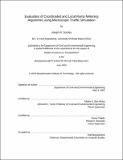Evaluation of coordinated and local ramp metering algorithm using microscopic traffic simulation
Author(s)
Scariza, Joseph R. (Joseph Ralph), 1979-
DownloadFull printable version (602.7Kb)
Other Contributors
Massachusetts Institute of Technology. Dept. of Civil and Environmental Engineering.
Advisor
Moshe E. Ben-Akiva and Tomer Toledo.
Terms of use
Metadata
Show full item recordAbstract
Ramp meters are special traffic signals at the end of a freeway on-ramp that regulate the flow of traffic onto the mainline. The main purpose of ramp meters is to keep the mainline of the freeway from becoming overly congested, and to maximize the efficient use of freeway capacity. The first use of ramp metering was in Chicago, in 1963, and today ramp meters are becoming more popular in both the US and in Europe. Although the original ramp metering controllers used pre-timed ramp meters, nearly all modern ramp metering algorithms are traffic responsive. Traffic responsive ramp meters can be divided into two categories: local or coordinated. Local ramp metering algorithms only take into account traffic conditions near a single ramp, while coordinated algorithms try to optimize traffic over an area. Four algorithms are evaluated in this thesis. ALINEA is a local ramp metering algorithm. ALINEA / Q is a local algorithm based on ALINEA, but handles ramp queues in a more efficient manner. FLOW is a coordinated algorithm that tries to keep the traffic at a predefined bottleneck below capacity. The Linked Algorithm is a coordinated algorithm that seeks to optimize a linear-quadratic objective function. Each of these four algorithms was tested on the M27 Motorway near Southampton, UK. Because none of the algorithms showed any significant benefits, different scenarios were tested, both on the M27 network, and on a generic network. The effect of four variables was studied: total demand, ramp spacing, proportion of traffic using ramps, and traffic distribution among ramps. A regression analysis was performed on each algorithm to determine the sensitivity to each variable. The most significant result was that ramp metering, especially the coordinated algorithms, was only effective when the ramps are spaced closely together. It was also observed that ramp metering was only effective at relatively high demand levels, and that ALINEA / Q and the coordinated algorithms were more effective than regular ALINEA when the volume was extremely high.
Description
Thesis (S.M.)--Massachusetts Institute of Technology, Dept. of Civil and Environmental Engineering, 2003. Includes bibliographical references (p. 105-108). This electronic version was submitted by the student author. The certified thesis is available in the Institute Archives and Special Collections.
Date issued
2003Department
Massachusetts Institute of Technology. Department of Civil and Environmental EngineeringPublisher
Massachusetts Institute of Technology
Keywords
Civil and Environmental Engineering.